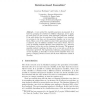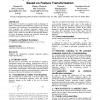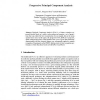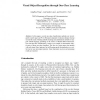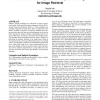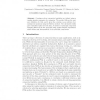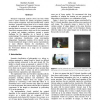CAEPIA
2003
Springer
14 years 8 months ago
2003
Springer
A new method for ensemble generation is presented. It is based on grouping the attributes in dierent subgroups, and to apply, for each group, an axis rotation, using Principal Com...
DOCENG
2003
ACM
14 years 8 months ago
2003
ACM
In this paper, we describe a comparative study on techniques of feature transformation and classification to improve the accuracy of automatic text classification. The normalizati...
ISNN
2004
Springer
14 years 8 months ago
2004
Springer
Abstract. Principal Component Analysis (PCA) is a feature extraction approach directly based on a whole vector pattern and acquires a set of projections that can realize the best r...
IDEAL
2004
Springer
14 years 8 months ago
2004
Springer
A common objective in image analysis is dimensionality reduction. The most common often used data-exploratory technique with this objective is principal component analysis. We pro...
ICIAR
2004
Springer
14 years 8 months ago
2004
Springer
Abstract. In this paper, several one-class classification methods are investigated in pixel space and PCA (Principal component Analysis) subspace having in mind the need of finding...
MM
2004
ACM
14 years 8 months ago
2004
ACM
Subspace learning techniques are widespread in pattern recognition research. They include Principal Component Analysis (PCA), Locality Preserving Projection (LPP), etc. These tech...
TSD
2005
Springer
14 years 8 months ago
2005
Springer
Abstract. We report work on the mapping between the speech signal and articulatory trajectories from the MOCHA database. Contrasting previous works that used Neural Networks for th...
PAKDD
2005
ACM
14 years 8 months ago
2005
ACM
Covariances from categorical variables are defined using a regular simplex expression for categories. The method follows the variance definition by Gini, and it gives the covaria...
IMC
2005
ACM
14 years 8 months ago
2005
ACM
Anomaly detection is a first and important step needed to respond to unexpected problems and to assure high performance and security in IP networks. We introduce a framework and ...
ICMCS
2005
IEEE
14 years 8 months ago
2005
IEEE
Principal Component Analysis (PCA) has been widely used to extract features for pattern recognition problems such as object recognition. Oliva and Torralba used “spatial envelop...
